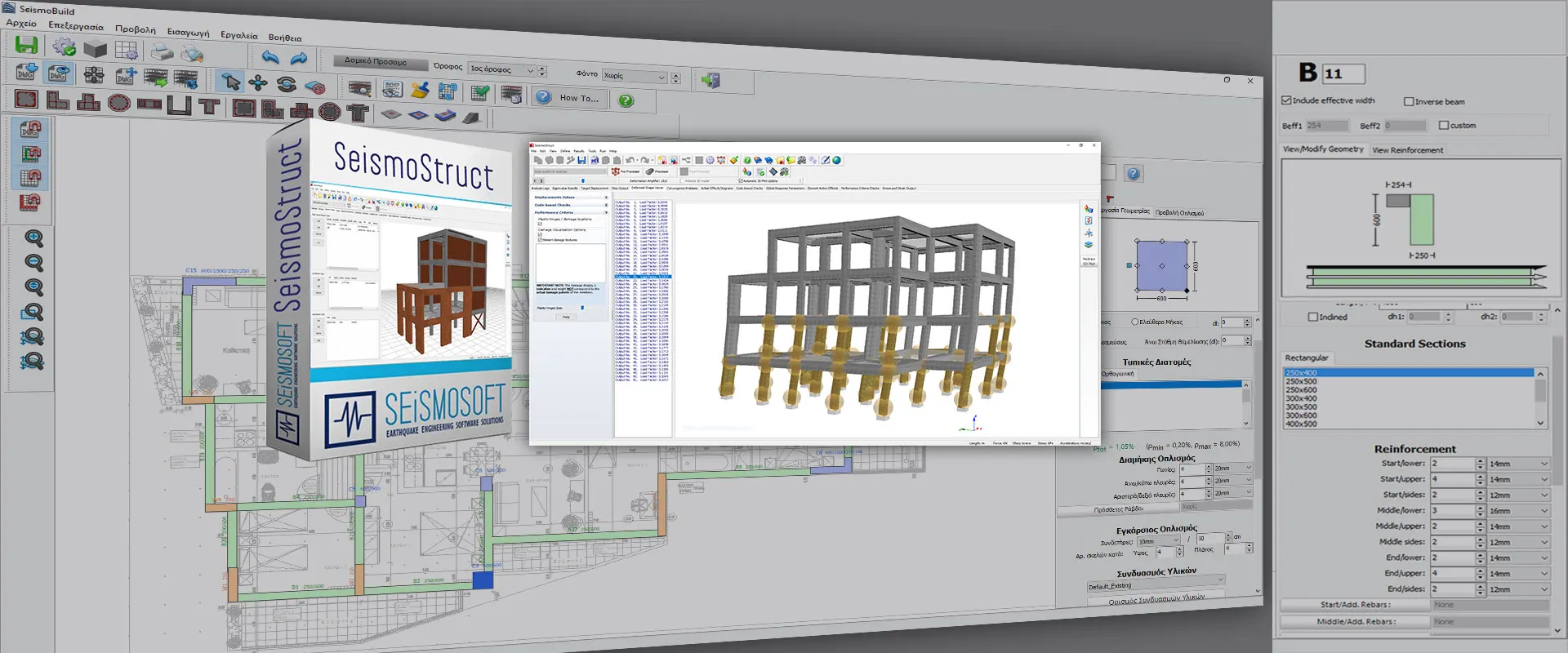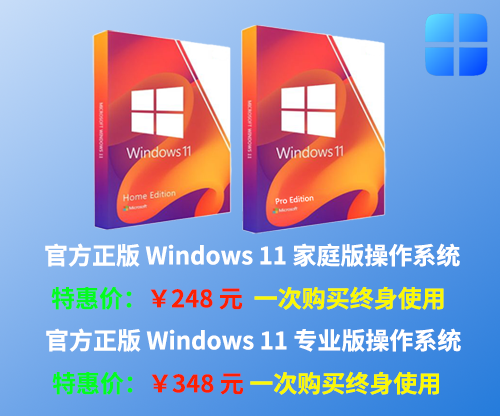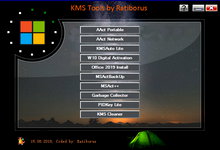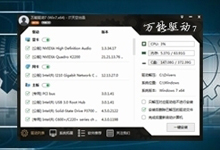SeismoSoft SeismoStruct 2024 R1 是一款分析空间框架结构在静力或者动力荷载作用下能考虑材料与几何非线性的有限元软件包。能够在静态或动态预测空间框架的大位移行为,同时兼顾几何非线性和材料无弹性。可提供混凝土,钢,frp和sma材料模型,以及可与预定义钢,混凝土和复合材料截面配置一起使用的大型3D元素库。它是一种用于结构评估和结构改造的土木工程软件,经过了严格的质量检验和验证。

SeismoStruct 2024 的一些功能总结如下:
- 可视化的界面。无需输入或配置文件,编程脚本或其他耗时且复杂的文本编辑要求。
- 与Windows环境集成。在电子表格程序(例如Microsoft Excel)中创建的输入数据可以粘贴到SeismoStruct输入表,以便于处理。相反,在SeismoStruct的图形界面中可见的信息都可以复制到外部软件应用程序(例如,文字处理程序,如Microsoft Word),输入和输出数据,图形,模型的变形和未变形的形状等等。
- 使用向导功能,用户可以创建常规/不规则的2D或3D模型,并即时运行类型中的分析。整个过程几秒钟。
- 使用Building Modeller,用户可以在几分钟内模拟正式的常规或不规则的3D钢筋混凝土结构,可模拟出高为100层的模型。它具有的基于CAD(例如AutoCAD文件)输入。
- 九种不同类型的分析:非线性动态和静态时间历程,常规和自适应推覆,增量动态分析,值,静态不变载荷,响应谱和屈曲分析。
- 21种材料模型,如非线性混凝土模型,高强度非线性混凝土模型,非线性钢膜结构,SMA非线性模型,砌体模型等。
- 线性/双线性/三线性运动硬化响应模型,间隙钩模型,土 – 结构相互作用模型,Takeda模型,Ramberg-Osgood模型等三十滞后模型。
- 七十二(72)个截面类型从的单一材料实心界面到更复杂的钢筋混凝土,钢和复合材料截面。
- 提供17种元素类型,允许相关人员表示/修复的结构构件和非构造构件,但也允许建立柔性基础,地震隔离,结构间隙/冲击等。
- 施加的载荷可以恒定可变的力,节点处的位移和加速度,以及分布元件力。可变负载可以在伪时域或时域中比例低或独立地的变化。
- 改程序考虑了材质的非弹性和几何非线性。
- 有多种钢筋混凝土,钢和符合材料可供选择。
- 沿着构件长度和横截面深度的非弹性扩展在SeismoStruct中明确建模,允许估计损伤累积。
- 在高的应变水平下的数值和精度使得能够地确定结构的坍塌负荷。
- 自适应pushover分析,在这种pushover方法中,根据在当前步骤中执行的值分析得出的模态形状和参与因子,横向载荷分布不保持恒定,而是不断更新。以这种方式,考虑了步骤中结构的刚度状态和周期伸长,以及的模式效应。该方法的基于位移的变型由于其能够根据系统的不断变化的模态更新横向位移模式,克服了固定模式位移推进的固有弱点,提供了有益的响应估计。
- SeismoStruct能够在出现收敛问题时巧妙地细分加载增量。细分程度取决于遇到的收敛困难。当克服收敛困难时,程序会自动将加载增量恢复到原始值。
- SeismoStruct的处理器具有位移曲线和结构变型形状的实时绘图,以及暂停和重新开始分析的能力。
- 根据Eurocode 8,ASCE41-17(美国现有建筑抗震评估和改造规范),NTC-18(意大利地震规范),NTC-08,可以进行旋转和剪切能力检查代码,KANEPE(希腊地震干预规范)和TBDY(土耳其抗震评估建筑规范),适用于钢筋混凝土结构和指定规范中的状态。
- 还可以设置性能标准,允许用户识别达到不同性能状态(例如非结构性损坏,结构损坏,坍塌)的瞬间。以这种方式获得整个结构中构件的开裂,屈服和失效的顺序。
- 后处理设施,包括自定义格式化派生图和变形形状的能力,从而提高用户的工作效率。
- 可以创建AVI电影文件以更好地说明结构变形的顺序。
- “SPF Creator”程序已在安装中。用户可以使用该程序与MS Excel等电子表格程序一起创建数百或数千个SeismoStruct输入文件,而编程技巧。SPF Creator可与SeismoStruct的批处理程序SeismoBatch一起使用,以地执行数千次分析(例如,用于推导脆弱性曲线)。
- Seismosoft致力于使用SeismoStruct成为很受欢迎的有限元分析软件,用于结构评估,强化以及结构干预的设计。
SeismoStruct v2024 的新增功能
新的分析/建模功能
1. 五种新的单元类型:(i) Elastic frame element with hinges, (ii) Shell element, (iii) Rack element with hinges, (iv) Linear link element和(v) Nonlinear damping element
2. 单独的基础、条形基础和连接梁可用于在Building Modeller设施内对地基进行建模
SeismoStruct is an award-winning Finite Elements package capable of predicting the large displacement behaviour of space frames under static or dynamic loading, taking into account both geometric nonlinearities and material inelasticity. Concrete, steel, frp and sma material models are available, together with a large library of 3D elements, such as nonlinear fibre beam-column element, nonlinear truss element, nonlinear infill panel element, nonlinear masonry elements, nonlinear link elements, etc., that may be used with a wide variety of pre-defined steel, concrete and composite section configurations. The program has been extensively quality-checked and validated, as described in its Verification Report. Some of the more important features of SeismoStruct are summarised in what follows:
- Completely visual interface. No input or configuration files, programming scripts or any other time-consuming and complex text editing requirements.
- Significantly faster analyses with the new parallel processing capabilities and a new sparse/profile solver.
- Full integration with the Windows environment. Input data created in spreadsheet programs, such as Microsoft Excel, may be pasted to the SeismoStruct input tables, for easier pre-processing. Conversely, all information visible within the graphical interface of SeismoStruct can be copied to external software applications (e.g. to word processing programs, such as Microsoft Word), including input and output data, high quality graphs, the models’ deformed and undeformed shapes and much more.
- With the Wizard facility the user can create regular/irregular 2D or 3D models and run all types of analyses on the fly. The whole process takes no more than a few seconds.
- With the Building Modeller the user can create real regular or irregular 3D reinforced concrete models within minutes and print tables containing all the model members and their characteristics.
- Easy input of infill panels and steel braces in the Building Modeller.
- New 3-sided, 2-sided and 1-sided jackets are available in the Building Modeller.
- Individual footings, Strip footings and Connecting beams are available for the modelling of foundation within the Building Modeller facility.
- Ten different types of analysis: response spectrum analysis, dynamic and static time-history, conventional and adaptive pushover, incremental dynamic analysis, eigenvalue, non-variable static loading, buckling analysis and tsunami nonlinear analysis.
- The applied loading may consist of constant or variable forces, displacements and accelerations at the nodes. The variable loads can vary proportionally or independently in the pseudo-time or time domain.
- The program accounts for both material inelasticity and geometric nonlinearity.
- A large variety of reinforced concrete, steel, composite and masonry sections are available.
- The spread of inelasticity along the member length and across the section depth is explicitly modelled in SeismoStruct allowing for accurate estimation of damage accumulation.
- Numerical stability and accuracy at very high strain levels enabling precise determination of the collapse load of structures.
- The innovative adaptive pushover procedure. In this pushover method the lateral load distribution is not kept constant but is continuously updated, according to the modal shapes and participation factors derived by eigenvalue analysis carried out at the current step. In this way, the stiffness state and the period elongation of the structure at each step, as well as higher mode effects, are accounted for. In particular the displacement-based variant of the method, due to its ability to update the lateral displacement patterns according to the constantly changing modal properties of the system, overcomes the inherent weaknesses of fixed-pattern displacement pushover, providing superior response estimates.
- SeismoStruct possesses the ability to smartly subdivide the loading increment, whenever convergence problems arise. The level of subdivision depends on the convergence difficulties encountered. When convergence difficulties are overcome, the program automatically increases the loading increment back to its original value.
- SeismoStruct’s processor features real-time plotting of displacement curves and deformed shape of the structure, together with the ability of pausing and re-starting the analysis.
- Features enabling easier convergence and possibility to display areas with plastic hinges or damage in 3D plot.
- Capacity checks in chord rotation and shear can be performed, according to the Eurocodes, the American Code for Seismic Evaluation and Retrofit of Existing Buildings (ASCE 41-17), the Italian National Seismic Codes (NTC-18 & NTC-08), the Greek Seismic Interventions Code (KANEPE) and the Turkish Seismic Evaluation Building Code (TBDY) and for all the limit states of the specified codes.
- Performance criteria can also be set, allowing the user to identify the instants at which different performance limit states (e.g. non-structural damage, structural damage, collapse) are reached. The sequence of cracking, yielding, failure of members throughout the structure can also be, in this manner readily obtained.
- Advanced post-processing facilities, including the ability to custom-format all derived plots and deformed shapes, thus increasing productivity of users.
- AVI movie files can be created to better illustrate the sequence of structural deformation.
- Possibility to easily create hundreds or thousands of SeismoStruct input files using the SPF creator module.
- SeismoStruct Batch module giving the ability to automatically execute numerous analyses in sequence.
- Possibility to easily send a model to Seismosoft, in the case of modeling or convergence problems, and get assistance by our team of specialists in nonlinear analysis.
官网地址:https://seismosoft.com/product/seismostruct/
软件下载地址:
SeismoSoft SeismoStruct 2024 R1 Build 1 x64 注册版 – 非线性有限元分析

 龙软天下
龙软天下

























评论前必须登录!
立即登录 注册本站